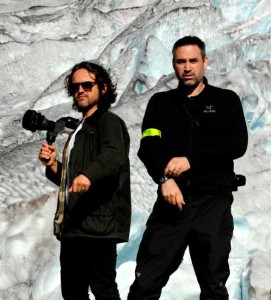
One of this year’s most successful independent movies, Ex-Machina is a stylish and edgy science fiction film that has captured the attention of audiences with its timely theme of Artificial Intelligence or AI. Basically a three-character film, it features three of Hollywood’s fastest-rising young actors – Oscar Isaacs, Dohmnall Gleeson and Sweden’s Alicia Vikander. It is helmed by English director Alex Garland who also wrote the screenplay.
The plot centers around Nathan (played by Isaacs) who is a multi-billionaire CEO of one of the world’s largest computer companies and who lives in a remote mountain retreat deep in a forest. Caleb (Gleeson), a young computer coder at the company, has won a competition to spend a week with Nathan. When he arrives, Caleb learns that he is being tasked with deciding whether a gorgeous female robot Ava (Vikander) not only is equipped with AI but has developed an independent conscience.
Ex-Machina is Garland’s debut as director. He also wrote the screenplay for the film. He first made his mark as a novelist and then as a screenwriter, most notably on several films with a dystopian theme including 28 Days Later and Sunshine directed by Danny Boyle and Never Let Me Go, directed by Mark Romanek. He has long had a fascination with technology – the disruptive role it plays in our 21st century world and the fears and insecurities it taps into. “People are paranoid about AI,” he noted. “It’s on people’s minds, as it should be. I approach it from a slightly different angle, because I don’t exactly feel paranoid about it. With Ex-Machina my sympathies lie with the robot.”
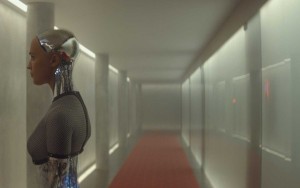
Though a first-time director he has learned the ropes having served as an executive producer on several movies that he scripted. Garland collaborated closely with the top-flight crew he assembled. “I’m not interested in the auteur theory of directing,” he noted. “I am much more into the craft it.” Several of the production keys he already knew, from having worked on a number of films with them. They include production designer Mark Digby, sound designer and supervising sound editor Glenn Freemantle and make-up and hair designer Sian Gregg.
Sammy Sheldon, the costume designer, fit the bill because of her experience creating the wardrobe on several science fiction films including X-Men: First Class. The editor, Mark Day, cut four of the Harry Potter features. The movie’s visual effects supervisor is Andrew Whitehurst, from top London VFX house Double Negative where he also supervised Skyfall, the most recent James Bond movie. Hair and makeup artist Sian Gregg came with recent credits for Wolf of Wall Street,The Great Gatsby and Django Unchained.
Ex-Machina was filmed on location for four weeks in Norway and also on set at England’s Pinewood Studios for the final two weeks. For the modernist, minimalist residence of Nathan, the techno-billionaire, where most of the action takes place, the Fjora House, a private residence in northern Norway, and the nearby Juvet Landscape Hotel provided many of the interior and exterior shots.
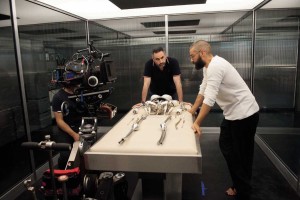 Digby and his team built Ava’s observation room, and other interiors, on stages at England’s Pinewood Studios, matching them to the design features of the locations and using bluescreen to add in the landscape through the windows. The set was a see-through glass cube that Ava lives in and thus is always observable. “Digby’s brilliant idea was to give Ava lots of room to walk around and keep Caleb in a tiny box, so that the girl who’s imprisoned has the space and the guy who’s breaking her out is trapped.”
Digby and his team built Ava’s observation room, and other interiors, on stages at England’s Pinewood Studios, matching them to the design features of the locations and using bluescreen to add in the landscape through the windows. The set was a see-through glass cube that Ava lives in and thus is always observable. “Digby’s brilliant idea was to give Ava lots of room to walk around and keep Caleb in a tiny box, so that the girl who’s imprisoned has the space and the guy who’s breaking her out is trapped.”
Meanwhile the world Nathan has created for himself changes as the film progresses. Said Garland: “The design trick becomes about making a house that at first seemed beautiful, desirable and classy feel suddenly scary, claustrophobic and dangerous.”
Garland worked closely with cinematographer Rob Hardy and his gaffer to light and photograph the scenic work Digby and his team had done. “There was no direct view of light sources,” said the director. “Everything was running down the walls, creating gauze-like effects.” Due to the location’s floor-to-ceiling glass windows, each of the house’s rooms takes on a different feel depending on the time of the day and the way it’s being lit. Hardy, “really picked up the ball and ran with it,” said Garland. “He transcended whatever requirement I could possibly have made of him. He elevated everything.”
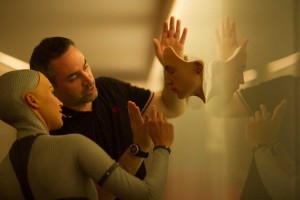 “The biggest challenge were the set ups with Ava,” pointed out Hardy who also talked with Below the Line. “There were five sessions with Ava, and I wanted to make them different psychologically so that each time there was an emotional progression.” Hardy made the most of shooting through glass capturing the play of light dancing through the surfaces. “I usually shy away from reflections, but in this film I decided to do it to the fullest.”
“The biggest challenge were the set ups with Ava,” pointed out Hardy who also talked with Below the Line. “There were five sessions with Ava, and I wanted to make them different psychologically so that each time there was an emotional progression.” Hardy made the most of shooting through glass capturing the play of light dancing through the surfaces. “I usually shy away from reflections, but in this film I decided to do it to the fullest.”
“Shooting through glass of course created problems like dealing with reflections,” said Garland. “But they’re so beautiful and you get these wonderful moments. Ava might move around the corner and as she does so she appears in it and then her reflection mirrors it. Some of it was by design, some of it was a happy accident. I often feel like one of the good things good production designers do is set up a whole set of accidents that might happen.”
Employing CGi can slow a production. But VFX supervisor Whitehurst and his team were on the set every hour of every day during the six weeks of filming, Garland pointed out. “They created a way we could shoot where we didn’t have to have any tracking markers or put up greenscreens,” noted the director. So Vikander as Ava “didn’t have to walk around with green sleeves or a green midriff that would have to be swapped out.”
Although the shoot was rapid, postproduction was a lengthy six months. Much of the time was spent by Whitehurst and the people at Double Negative doing the special effects, which mainly involved filling out Ava who was designed as a see-through robot.
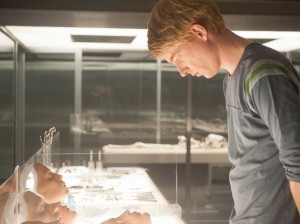 The task of creating the look of Ava also fell to costume designer Sheldon. “We approached Sammy because she had experience making superhero costumes, and we knew we needed a costume that would be practical at times,” Garland explained. “The costume needed to have some overt design elements, but also maintain Alicia’s silhouette without bulking her out at all. It was a surprisingly complicated job.”
The task of creating the look of Ava also fell to costume designer Sheldon. “We approached Sammy because she had experience making superhero costumes, and we knew we needed a costume that would be practical at times,” Garland explained. “The costume needed to have some overt design elements, but also maintain Alicia’s silhouette without bulking her out at all. It was a surprisingly complicated job.”
Sheldon understood the mechanics of creating a very fitted skin-tight costume, from her experience on films like X-Men. “This costume is effectively Ava’s skin, she’s not wearing clothes,” the director pointed out. “Sunny had a particular experience. She knew how to sew material so there weren’t these ripples and bulges you encounter in most costumes. She knew how to get rid of them.”
The music and the sound were also important elements in the film. The experienced Freemantle did the sound design for Ex-Machina while the score was provided by two musicians from different backgrounds. Jeff Barrow was a music producer and performer. He had been a member of the band Portishead, and had never worked on a film score. Ben Salisbury had composed the music for more than 100 television and film productions.
Freemantle is an Academy Award-winning sound designer. He won an Oscar for sound editing on Gravity. “Glenn has worked on every movie I’ve worked on,” noted the director. “He’s incredibly creative and a supreme technician, and he understands the grammar of filmmaking deep in his bones.” There are long periods of silence in the movie and a challenge for Freemantle was to add a subtle sound design for these spans.
Barrow and Salisbury’s score tried to stay away from the tried-and-true. “We wanted to steer away from a certain kind of electronic score that you could easily move towards with sci-fi and robots,” said Garland. “They gave themselves various kinds of rules about things they weren’t going to use and things they would use in particular ways. The score is, in some ways, controlled and understated, but then at times it really flexes its muscles and does something extreme. It’s a very strange score, but it’s really fantastic.”





